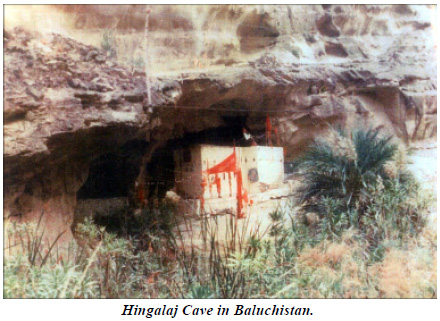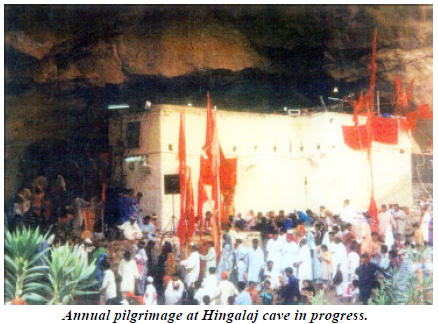The Goddess Hingala Of
Baluchistan
By Sanjay
Godbole
Baluchistan
is a State in
Pakistan, having
a fairly vast expanse. Hingola is an ancient
river, which traverses across the terrains of
Baluchistan.
A mountain named ‘Khirdhar’ is situated at the
banks of river Hingol. At the extreme end
portion of this mountain, which is popularly
known as Kanraj, there is an ancient cave known
as ‘Hingalaj’. This place is situated in
Tehsil
Lyari of Baluchistan
and is, since ancient times, reckoned as the
largest and the most famous place of Worship of
the Goddess Hingla in the Indian Sub-continent.
The “Hingalaj” cave is located at a distance of
250 kilometers from “Karachi”
on Karachi-Quetta highway. On the eastern side,
is situated a town called Lyari. Next to Lyari,
not very far, is located a military base of
Baluchistan.
One has to cross two rivers named Aghor and
Gungi, to arrive at
Ashapura Sarai
hermitage’ charitable rest house for a camping
halt where the Hingalaj cave is situated in the
near vicinity.

At this
location, there are some old temples of
worshiping such as Lord Ganesha, remains like
Goddess mother Kali, Guru Gorakhnath, Brahmkunda,
Ram Zarokha, Anil Kund and holy place of Gruha
of Goddess Devi.
During the Treta-Yuga
epoch or era (according to Hindu mythology there
are 4 yugas (Eras) Satyayug Dwaparyug,
Treta-Yuga and Kalki-Yug .When
Parshuram incarnated, Dadhichi the
Famous ascetic sage had penned a predictive
story. King
Vichatar,
a descendent of a Tartar Mangol Dynasty,
ruled this province. He had two sons, named
“Hingol” and “Sunder” Sunder brutally
oppressed the populace. The harassed public,
propitiated Lord Shiva, and the Lord Ganesha
(Son of Shiva). Lord Ganesha killed Sunder.
Later on,
Sunder’s brother, Hingol, who had received
boons, which ensured that he (Hingol) would not
meet death by any weapon whatsoever, in any of
the three lokas (worlds)' as per Hindu
mythological concept three worlds exist worlds
Swarg, Mrityu.
Pataal
Hingol,
all the same, would not remain immune to death.
Hingol soon became insolent and opressed his
subjects. He also added new territories to his
Kingdom. He, thereafter, suo moto, assumed the
title as Hingol
Dev (God
Hingol). Ultimately, the people as a resultant
reaction, worshipped “Goddess Shakti”.
The Goddess
killed Hingol in a cave at a place known as “Satdeep”
in, what is known as ‘Baluchistan’today. Hingol,
just before meeting his death, requested and
prayed to Goddess Shakti, that he be identified
and be synonymous with his name. The place,
thenceforth, was known as “Hingol
Tirth”.
When Alexander
the great, invaded “Sistan” now called
“Baluchistan”
presently, in the year 325 B.C., the Greek
forces were camping at the banks of river “Hingol”.
Sikandar waged a war with the King of “Balikot”.
Some devotees of Goddess Hingla were there, to
worship the Goddess Hingla and they were all
safe.
Emperor
“Vikramaditya” at the time of Vanquishing India,
visited this place as a devotee. King, Todarmal,
contemporary of Emperor “Akbar” had also visited
this place as a devotee. So also did many Rajput
nobles, and personalities such as Biharimal,
Madhusingh, & Raja Jagtatsingh visit the place.
Dada Mek-han,
the famous saint of Gujrat, came all the way
from Gujarat,
to visit and have glimpses of this holy place.
Those devo-tees, visiting this place Hingalag
are addressed as ‘Kapdis’. The pilgrims, after
completion of their pilgrimage, sport a string,
made out of “Thumra”, a variety of stone, mined
from “Thatta” in Sindh.
Prior to the
partition of British India, in 1947, many
devotees, especially from “Gujarat”
and “Rajasthan” regularly visited “Baluchistan”
to propitiate Goddess “Hingla”. Travelling was
not that easy and comfortable at that time. The
travellers had to undertake the tedious journey
by braving the barriers such as rough and
sloppery roads, jungles, mountains and crossing
of challenging rivers. This tedious journey, at
times had to be completed on the back of camels
or in a Palanquin and would last for about a
month or so.
Shri Varsimal
Devani, a Trust of Swami Narayan Temple , a
religious cult popular as Vaishnava, residing on
Mohamad Ali Jinnah Road in Karachi, is also a
trusth of Hingla Mata Temple of Baluchasitan. He
also arranges tours to Hingla
Teerth.
He very graciously made available to me some
fine photographs of
Hinglamata
Mandir.
According to
Shri
Devani,
the Goddess Hingla Devi being famous all around,
devotees from Africa and even
Europe
frequent this pilgrimage spot in multitudes.

As per the
legend, in Uttar
Ramayana,
Lord Rama visited Hingla
Teerth in
a sortie in his aircraft “Pushpak”
and bathed in the water basin (Jal
Kunda)
here. One spot in this area is identified with
Lord Rama’s sacred visit.
Shri. Devani
further added, that the temple of
Hingla Mata
is inside a cave and it admeasures 25 feet by 12
feet. There is no idol of the deity, but only
the Astan (Seat) and the trident.
A priest is duly
appointed for carrying out daily rituals and
general maintenance and house keeping.
Each year a
minimum of Twenty five thousand strong contigent
of devotees visit there for pilgrimage. They
offer flowers and coconuts to the Goddess Hingla.
Some offer a cloth piece suitable for Blouse,
making such an offer is considered to be
auspicious. Some offer “Saubhagya Lenis” and
even silver canopies Umbrellas i.e. according to
Hindu belief, a married lady is considered to be
fortunate, if she passes away prior to her
husband. Since dry fruits are available in
abundance in Baluchistan,
these are offered to the deity and are
distributed to the visitors as blessings of the
deity.
Devani said that
the members of “Zigri”, a Baluch tribe reside in
this area. They also worship the deity and take
a vow. When their vows are fulfilled these
“Zigri
Baloch
come to the spot and offer Mithi roti (Sweetened
Bread). All the members of their family gather
on such an occasion. They address Hinglamata as
“Nanima” . (Nani means mother’s mother ). All
the security personnel of this temple are Baloch.
This was specifically mentioned by Shri.
Varsimal Devani.
As per the
legend described in “Shiva-Purana” Sati’s main
mortal remains fell over this part of the land.
Sati was the daughter of “King Daksha” and wife
of Lord Shiva who preferred to go “Sati”. (Sati
according to orthodox Hindu beliefs, a married
woman after the death of her husband should
immolate herself on the pyre of her husband ,
this it is claimed is necessary for her salvage
in future births) . Hence this place assumed
importance in the specified holy places of the
Goddess.
But exactly like
the “Sharada” temple in Kashmir, this place
Hingla
Teerth is
now in Pakistan. Hence we (Indians) are deprived
of an easy access do this place.
*(The author is
a noted Archeologist, a linguist and expert on
the history of South-West Asia)
Source: Kashmir
Sentinel
| 















No one has commented yet. Be the first!